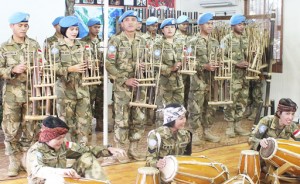Because of the collaborative nature of Angklung music, playing promotes cooperation and mutual respect among the players, along with discipline, responsibility, concentration, development of imagination and memory, as well as artistic and musical feelings.
— UNESCO
As a performer of Javanese gamelan music who lives in Beirut, I’ve been dreaming of bringing Indonesian music to Lebanon–but it looks like the Indonesian military beat me to it this past week-end.
On Saturday in southern Lebanon, members of the Indonesian Military (TNI) in the United Nations Interim Force in Lebanon (UNIFIL) played angklung music for an audience of personnel from the French Force Commander Reserve to demonstrate Indonesian music as part of a cross-cultural exchange. Angklung is a musical instrument from Indonesia made from two to four bamboo tubes suspended in a bamboo frame. Because each one produces a single pitch, players must rely on one another to make a melody. In Bali, angklung music is often played for temple anniversaries or in rituals related to death, such as the cremation ceremony (ngaben). In addition to traditional Indonesian music, angklung can be used to play everything from Beethoven to Queen.
In 2010, UNESCO inscribed angklung on the Representative List of the Intangible Cultural Heritage of Humanity. In the video below, you can see how an angklung is made.
Angklung promotes social harmony, teamwork, and mutual respect. The angklung orchestra, usually made up of twenty players, is considered a symbol of our interdependence, with each instrument making a singular contribution to the beauty of the the greater collective harmony…
